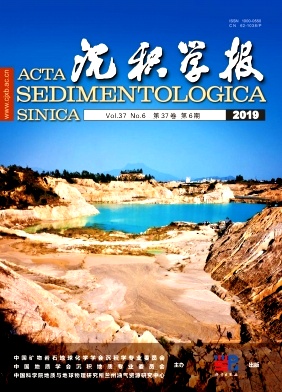Testing the Reliability of Adams Formula and Couch Formula for Estimating Paleosalinity: Case study of the Buha River Estuary,Qinghai Lake
doi: 10.14027/j.issn.1000-0550.2019.009
- Received Date: 2018-11-08
- Rev Recd Date: 2019-01-30
- Publish Date: 2019-12-10
-
Key words:
- Adams formula /
- Couch formula /
- TOC /
- boron adsorption /
- Qinghai Lake
Abstract: The Adams formula and Couch formula are commonly used for quantitative estimation of the paleosalinity of sedimentary water by measuring the concentration of boron in the sediment. However, the paleosalinity values are open to doubt due to the great difference between the values calculated by the two methods. To test the reliability of the two formulas, samples were collected from surface sediments and underlying water in different sedimentary environments in the Buha River estuary of Qinghai Lake. The concentration of boron, total organic carbon (TOC) and mineral composition of the deposits were derived, and the salinity and boron concentration of the water body were measured. The results for the lake water showed an excellent linear positive correlation between the concentration of boron and salinity, but no direct correlation between the concentration of boron in sediments and in sedimentary water. Based on the concentration of boron in sediments and the content and composition of clay minerals, the water salinity was calculated by both the Adams formula and the Couch formula. The calculated water salinity was higher than the measured salinity; although the value calculated by the Adams formula differed most from the measured values, it was positively correlated with the boron content in the sediments.The boron in the sediments mainly comprises boron inherited from the mother rock, boron adsorbed by clay minerals and boron-enriched organic matter. Of these, only the adsorbed boron reflects the salinity of water. The sediments in the Buha River estuary of Qinghai Lake are rich in organic matter. The strong enrichment effect of organic matter on boron content is an important reason for the failure of the salinity estimation by both formulas. Differences in the boron adsorption capacity of different types of clay minerals also significantly influence the results:the immersion tests of clay minerals in salt water showed that montmorillonite has the strongest affinity for boron adsorption, followed by illite and kaolinite. This contradicts Couch's understanding that illite has the strongest boron adsorptive capacity. Neither the original Adams formula nor the Couch formula consider the effect of organic matter on the boron content, and the misunderstanding of the adsorptive capacity of different types of clay minerals renders both formulas unsuitable for estimating paleosalinity in terrestrial sediments. Nevertheless, the concentration of adsorbed boron in clay minerals in the sediment remains a reliable index of the salinity of sedimentary water.The recovery of paleosalinity must first eliminate the influence of organic matter on the boron content, then determine the boron adsorption coefficient of the different clay minerals by carrying out a series of immersion tests and establishing a new formula.
| Citation: | MA MingMing, WANG ChangYong, XU XingBin, WANG XiaoYu, FEI Ying, LI YaNan. Testing the Reliability of Adams Formula and Couch Formula for Estimating Paleosalinity: Case study of the Buha River Estuary,Qinghai Lake[J]. Acta Sedimentologica Sinica, 2019, 37(6): 1224-1233. doi: 10.14027/j.issn.1000-0550.2019.009 |






 DownLoad:
DownLoad: